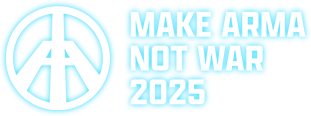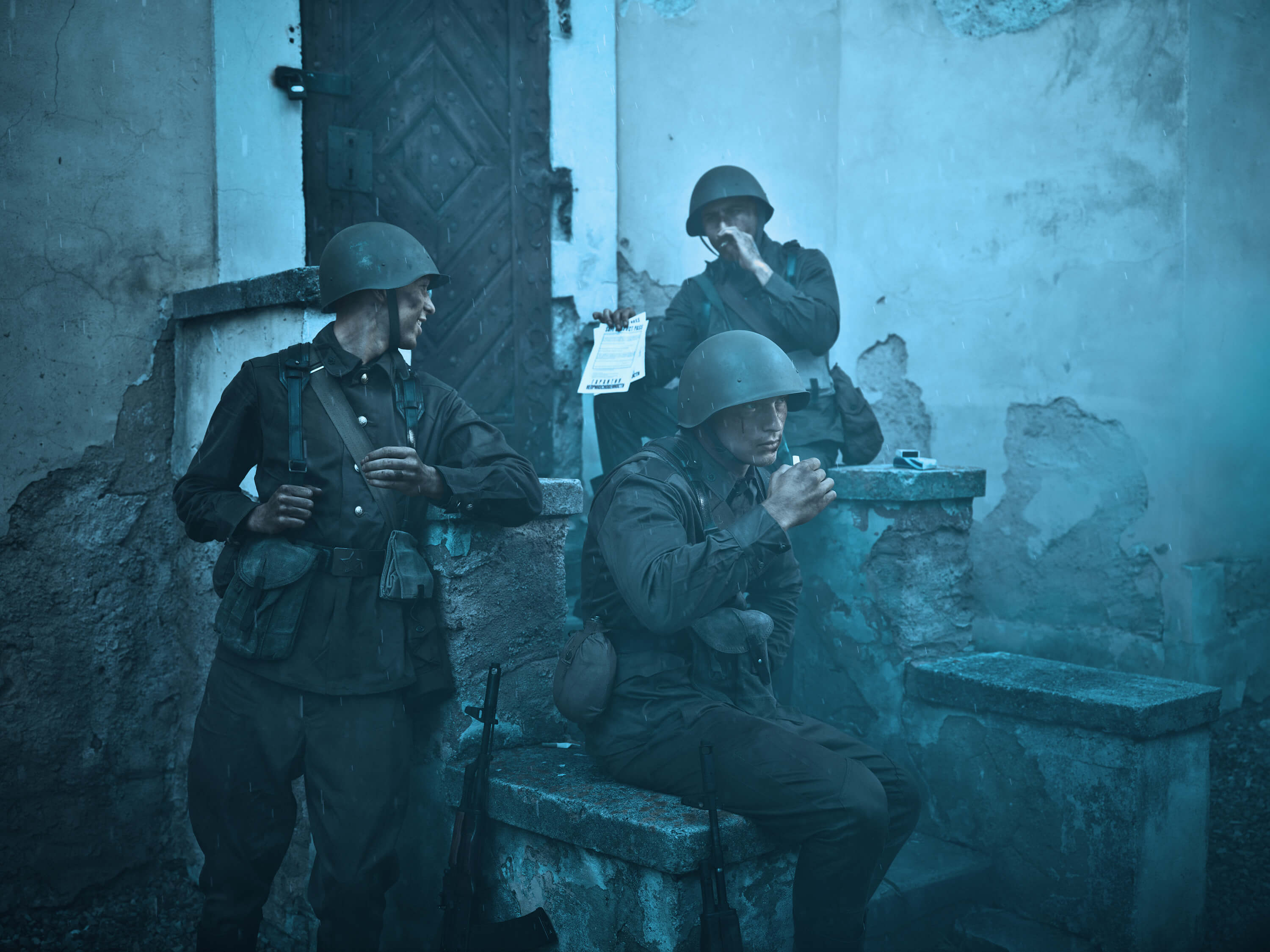Radio Check
Effective communication with your squadmates on the battlefield can mean the difference between life and death, as well as victory or defeat. Our goal with this Boot Camp is to outline Arma Reforger's radio systems, and how - and when - to communicate relevant information via voice and text in an efficient and concise manner.

Types of In-game Comms
Proximity Chat
To communicate via voice to individuals - both friend and foe - nearby, you can press and hold T on your keyboard and speak into your microphone.
You can also toggle voice communications by double-tapping T on your keyboard (or pressing LB on Xbox, L1 on PS5).
Handheld Radios
Handheld radios allow you to communicate with your squadmates and others on your team over distances that would be impossible with just Proximity Voice Chat. To transmit over a handheld radio in your inventory, press and hold CAPS LOCK on your keyboard (Hold LB on Xbox, hold L1 on PS5) and speak into your microphone.
To access the radial Radio Select Menu and adjust which frequencies you are currently listening to, press G on your keyboard (LB + X on Xbox, L1 + Square on PS5). You can then move your cursor/selection to one of two channels available and set it as your active one. You will be able to hear both channels, but can only talk on the one you have currently selected as "active."
Should you need to quickly cycle between your two tuned channels, double press CAPS LOCK (LB + B on Xbox or L1 + Circle on PS5).
You can also use your mouse SCROLL WHEEL (Up and Down on D-Pad on Xbox or PS5) to adjust a selected channel's frequency up or down in 0.5 KHz "steps."
You can use Q / E ( Left and Right on D-Pad on Xbox or PS5) to cycle between predetermined channels with set frequencies for the Platoon, and for each Group on your team.
Finally, pressing R (Hold LB + press RS to turn on/off on Xbox, or Hold L1 + press R3 to turn on/off on PS5) while a channel is highlighted will toggle the power state of your radio.
Manpack Radios
Manpack Radios allow you to speak to members of your faction at an even longer distance than handheld radios, and also has both lower and higher frequencies available for use in comparison to handheld radios. To speak on a Manpack radio, you can either have it selected as your active channel and press and hold CAPS LOCK (LB on Xbox, L1 on PS5), or, if you are carrying and using a Handheld Radio in tandem with your Manpack, you can press L-CTRL + CAPS LOCK (LB + A on Xbox, L1 + X on PS5) to transmit, leaving CAPS LOCK assigned to your Handheld Radio.
Text Chat
You are also able to communicate with other players through text chat in-game. By pressing / (LB + Y on Xbox, L1 + Triangle on PS5) you will open a chat window you can then type a message into. You can then send the message by pressing ENTER (A on Xbox, X on PS5) or discard the message by pressing ESC on your keyboard (Menu button on Xbox or PS5).
You can view your chat history by using the SCROLL WHEEL on your mouse (Up and Down on D-Pad on Xbox or PS5).
By pressing the UP or DOWN arrows on your keyboard (Left and Right on D-Pad on Xbox or PS5), you can switch between the four different text channels:
Global - All players
Faction - All friendlies
Group - All friendlies in your Group
Vehicle - All players in your vehicle
Local - All nearby players
Be sure you have the correct one selected before typing and sending a message! You don't want to be the person who gives sensitive information to the enemy in Global Chat!
Command Orders
As a Squad Leader, you can issue orders by bringing up the Command Menu by pressing ~ on your keyboard (D-Pad Left + LB on Xbox, D-Pad Left + L1 on PS5) and selecting a desired command from the radial menu. When you do so, your character will make the appropriate hand gesture and a voiceover line of the selected command. A 3D marker will appear on-screen in the battlespace where you are currently looking or pointing your weapon.
Visual Communication
There are a few different methods of visual communication that can be used in Arma Reforger.
Point with your left index finger by pressing L CTRL + ~ (Unassigned on Xbox and PS5). Use this to indicate something in the distance or nearby to friendlies.
Lean your character from side to side (aka the "friendly wiggle") to indicate to a friendly at distance that you are also a friendly.
Smoke grenades are not only for concealment. Colored smoke grenades can be used to mark friendly positions (generally green or yellow smoke), enemy positions (generally red), and landing zones for helicopters (generally violet). Depending on what you have in your inventory, you may need to use a different color and communicate over the radio what it is marking. One thing to note is that colored smoke has the disadvantage of indicating positions to the enemy or letting them know they are spotted.
Map markers are another method of visual communication with your group and faction. You can indicate friendly and enemy positions or units - including their type and size; you can mark friendly and enemy minefields; you can mark paths of ingress or egress; you can mark waypoints, rally points, landing zones, or generally any other item of interest.
By RIGHT-CLICKING (Double press X on Xbox) on a desired location on the map, you will bring up a radial menu that will allow you to select "Markers," and from here, "Custom" or "Military Markers."
With "Custom" markers, you have several marker types that you can choose from between "General," "Arrows," and "Maneuvers." You can also select the desired marker color, enter some custom text, and change the marker's rotation with a slider that goes from -180° to 180°.
With "Military" markers, you will be able to select the faction (which will change the shape and color of the marker, as per NATO Joint Military Symbology), the category (air, land, or installation), the type (e.g. infantry, motorized, artillery, etc.), and then some custom text.

How to Communicate Effectively
Communicating effectively on the battlefield can give your team a significant advantage over less well-organized factions. Here are some tips for communicating effectively.
Keep comms clear, relevant, and brief.
Communicate important information in as few words as possible.
Consider what you need or want to say before doing so.
DON'T speak needlessly and incessantly while in combat in Proximity Voice Chat or in radio comms. Irrelevant and verbose information clutters radio traffic, and key information might be missed by you or others.
DON'T clutter the Platoon net with communications relevant to isolated engagements or movements. That is what your Group's designated channel frequency is for.
Make a habit of calling out important activity, locations, directions, or events. Always try to:
Call out sightings and locations – with the number and type of enemy, along with approximate range, and appropriate compass azimuth/bearing. Giving any quick descriptions of nearby landmarks will also help.
Give as much info as possible, concisely and quickly. All of this will be contextual to a given situation. You may find you will only be able to quickly give a general clock position/bearing, or a cardinal (N, E, S, and W) or intermediate (NE, SE, SW, and NW) compass direction. You may also only be able to give limited information from your vantage point, or while under fire, or feel that some pieces of info might be irrelevant, such as distance.
Be aware that there is a difference between calling out a visual and a contact.
A visual will indicate an enemy that is unaware of you and is not actively engaging you. For example: "I've got a visual on an enemy sniper, bearing 142, 300 meters away, second floor, second window from the left of the white house with the brown roof, between the two with yellow walls."
A contact will be an enemy that is aware of your presence, and is about to or is already actively engaging you. For example: "Contact! Enemy infantry squad, 2 o'clock, about 100 meters, moving left to right through the valley!"
If you are the Squad Leader, communicate when you want the squad to move or halt, and also know where your soldiers are at all times. If you are a squad member, you should acknowledge these orders and respond when appropriate. When using small unit tactics such as bounding over-watch, you will need to indicate when you are moving or when you are "set" and have stopped. Knowing where your squadmates are in a firefight is imperative - otherwise, you might get left behind!
As a Squad Leader, you may also need to indicate to your squad what formation to adopt, if they are in a stealth or combat posture, or to maintain spacing and not bunch up. The amount of micro-managing required will vary between squad members with different levels of experience or familiarity.
State which direction you are covering and listen to squad members when they do the same if you are in a defensive position and can speak without compromising your squad. You don't want to have the squad all looking in the same direction and have the enemy sneak up on a flank! The Squad Leader can either assign directions to different squad members to cover or ask what is being covered, so any gaps in your defense can be adjusted.
Communicate if you are engaging or disengaging with the enemy.
If you have eliminated an enemy, communicate this to your Squad, or if relevant, the Platoon.
If you are the Squad Leader, you will want to communicate when you want players to engage or disengage, or if they are "weapons free" or need to hold fire unless fired upon, especially if you are trying to maintain stealth.
You can also communicate to squad members when you want suppressive fire, or for squad members to cease fire.
Indicate if you are reloading your weapon, especially if you are a machine gunner or AT, so your squadmates can cover you.
Obviously, calling out that you are reloading could put you at a disadvantage if enemy are within hearing range - or even at an advantage if you want to trick them into thinking you are reloading, and to expose themselves to fire.
If you are running low on magazines, ammo boxes, or any other type of munitions or consumable items, you can let your squadmates know so you can either be given what is needed or so the Squad Leader can determine if they need to figure out a way to get a resupply.
A good Squad Leader will periodically ask their members for a status check for munitions.
Indicate if you are wounded to your squad so you can receive help, especially if you are about to pass out! Otherwise, your body might get left behind in the tall grass of some forgotten corner of Everon's woods.
Assume the enemy is ALWAYS LISTENING and let that inform how you communicate in combat. The enemy can hear you in Proximity Voice Chat, when you are speaking into your radio, and on captured radios. They cannot, however, hear your teammates speaking to you through your radio.
Only speak when necessary - especially when assaulting and clearing locations likely to be occupied by the enemy. Speaking can give away your position, but you can also hear the enemy in close proximity. You can use their voices to figure out where they are when in a firefight, or use a captured radio from a fallen enemy to try and discern OPFOR movements across the entire terrain.
Refer to objectives by their assigned phonetic code names, which are randomized per session and are specific to your team (e.g. "Mississippi" instead of Figari). This also applies to player-placed objective markers, waypoints, rally points, casualty collection points, landing zones, TRPs, and other map markers.
Do not refer to objectives by their place names on the map. If the enemy is listening in on your communications, you will have given away your location, movements, or operations plan to them.
NOTE: There is an exception to this rule. It is possible for the enemy to discern what place a code name refers to, if they are able to witness an event that is being called over the radio (such as a specific engagement, or a call-out for a specific vehicle around a location). If a specific call-out will clearly compromise a code name for a location, just use the actual location name - thus not revealing the code name for that particular location.
If your radio frequency has been compromised, change it. You will need to switch to a newly agreed-upon frequency to continue communications. You can use Faction Text Chat to indicate you will be adjusting your frequency without the enemy knowing, and what that frequency will be.

Procedure Words
Procedure words, also known as "prowords," are phrases used in radio communications to facilitate clear and concise messages in a standardized form.
Although more casual players are unlikely to use prowords while speaking on the radio, the enthusiast player who is more "milsim" minded will likely use at least some of them in their communications. A familiarity of common prowords could be indispensable during a gameplay session, so we have included this section on them in this Boot Camp.
Below are a series of English language prowords commonly used by Western military forces that you are likely to hear in-game while fighting over Everon and Arland:
STATION - An identifier on radio comms that is usually, but not always, a CALLSIGN. If you are unaware or unsure of who is calling you, you can use LAST STATION to refer to whoever was the last person to transmit over a frequency.
ALL STATIONS - This message is relevant to all parties listening to a particular frequency.
THIS IS - This transmission is from the STATION whose designation immediately follows.
Ex: “Alpha 1-1, THIS IS Alpha 1-2...”
SEND TRAFFIC / SEND MESSAGE - Used to indicate you have received an initial THIS IS transmission, and for the calling STATION to send their message.
Ex: "Alpha 1-2, this is Alpha 1-1, SEND TRAFFIC."
INTERROGATIVE - Used to indicate that a question will be asked.
Ex: Alpha 1-1, this is Alpha 1-2, INTERROGATIVE, over.
CORRECTION - Used when a transmission or a portion of a transmission was sent in error, and needs to be corrected. This can be combined with BEFORE or AFTER.
DISREGARD - Disregard the previous transmission.
BREAK - Used to indicate a pause in a transmission, but indicates to the listener that you still have more to transmit, so they shouldn't interrupt and await further communication. This can be used to break up longer transmissions of information, to halt due to an event (for example, you have new information, are in contact with enemy, or you are maneuvering) or to give yourself a moment to better phrase the remainder of your transmission.
AFFIRMATIVE - Yes.
ROGER - Can be used similarly to AFFIRMATIVE, but also to indicate that a transmission has been received and understood.
HOW COPY - A request for confirmation that your transmission has been received and understood.
SOLID COPY - Indicates that a transmission has been received and understood.
WILCO - Indicates that a message has been received and understood and that you "will comply."
NEGATIVE - No.
WAIT ONE - Indicates to the listener to wait a minute for your to respond.
YOU ARE COMING IN... - Usually used with a 1-5 x 5 (e.g. "three by five") to indicate how clear a transmission is being received when asked. 1 indicates the transmission is unintelligible while 5 is clear. 2, 3, 4 indicate varying levels of clarity between 1 and 5.
"Alpha 1-1, YOU ARE COMING IN THREE BY FIVE, over."
SAY AGAIN - Used to indicate that you need a transmission to be repeated for clarity or to re-confirm a piece of information. This can be combined with BEFORE, AFTER, and LAST as modifiers.
NOTE: DO NOT substitute REPEAT for SAY AGAIN. REPEAT is a proword specific to call for fire missions, such as artillery and close air support (CAS) to repeat their last strike.
BREAK BREAK BREAK - Used to indicate you need immediate cessation of communication on a particular frequency so you can transmit a high-priority message.
RADIO SILENCE - Used to indicate you to clear all communications over a net frequency, either to hear other information or to hear environmental or enemy movement/direction of fire.
OVER - Indicates the end of a transmission, and a response is expected.
OUT - Indicates the end of a transmission, and no answer is expected.
NOTE: Since OVER and OUT have opposite meanings, they are never used together.
Jargon
Jargon are phrases that, much like prowords, can also facilitate quick and understandable communication. You will likely hear someone at some point use one or more of the following during an Arma Reforger gameplay session:
MIKE - A minute.
Ex. "...in 20 MIKES..."
Click - A kilometer.
OSCAR MIKE - On the move.
Ex. "...We are OSCAR MIKE..."
STEPPED ON - Indicates that a transmission was talked over by another individual.
Note:
Just like a well-thought-out plan might not survive first contact with the enemy, prowords, jargon, and procedures in general can break down entirely when ordinance starts flying. At that point, your survival will primarily depend on getting information out on comms as fast and as effectively while under stress. What you are saying being as clear and understandable as possible is what matters the most, and these prowords can be seen as an effective tool or guideline to help keep communications standardized and concise more-so than a rigid and necessary structure during gameplay. But, like any other standard operating procedure (SOP), learning and practicing these things can make you a more efficient soldier, or could save you on the battlefield. These will obviously vary based on the language spoken, or if in an organized unit or community, what has been decided to be their SOPs.

Radio Specifications
Handheld Radios
AN/PRC-68
First issued to the US Marine Corps in the 1970s and later adopted by the US Army in the 1980s, the AN/PRC-68 is a short-range, handheld radio, intended for small squad communications. It has a unique modular design, allowing for easy repair in the field. The unit's electronic configuration is also completely solid state, with synthesized, pre-set channels and battery-saving features, meaning it is both efficient to use and highly reliable.
Info:
Usable when placed anywhere in the player's inventory
Costs 0 units of Supply Points if taken from an Arsenal or an M934A1 Command Truck
Weighs 1.3 kilograms
Takes up a single inventory slot
Lowest tunable frequency: 32.0 MHz
Highest tunable frequency: 68.0 MHz
By default, the radio's Channel 1 is tuned to your Group's predetermined frequency, while Channel 2 is tuned to the Platoon channel (48 MHz)
Frequency resolution is limited to steps of 0.2 KHz
Maximum transmission range of 1.3 kilometers
R-148
The R-148 is a handheld combat-net radio transceiver that operates on a short-wave band. Considered a cost-effective response to the success of the US Army's AN/PRC-68, its antenna affords improved coverage compared to older models.
Info:
Usable when placed anywhere in the player's inventory
Costs 0 units of Supply Points if taken from an Arsenal or a Ural-4320 Command Truck
Weighs 3 kilograms
Takes up a single inventory slot
Lowest tunable frequency: 38.0 MHz
Highest tunable frequency: 54.0 MHz
By default, the radio's Channel 1 is tuned to your Group's predetermined frequency, while Channel 2 is tuned to the Platoon channel (48 MHz)
Frequency resolution is limited to steps of 0.2 KHz
Maximum transmission range of 1.3 kilometers
Manpack radios
AN/PRC-77
The AN/PRC-77 is a portable, VHF FM combat-net radio transceiver, manufactured by the United States in 1968 for the Vietnam War. Although much larger and heavier than handheld units such as the AN/PRC-68, its manpack design allows it to be carried on the back, providing effective, mobile communications on the battlefield. It is typically fitted with voice encryption devices.
Sometimes referred to as the 'Prick-77', it remains as the primary squad-level radio of the US military.
Info:
Worn in the player's backpack slot
Costs 50 units of Supply Points if taken from an Arsenal or an M934A1 Command Truck
Weighs 9 kilograms
Has zero storage capacity
Takes up 2x2 inventory slots and has a volume of 10,000 cm3
Lowest tunable frequency: 30.0 MHz
Highest tunable frequency: 76.0 MHz
By default, the radio is tuned to 48.0 MHz
Frequency resolution is limited to steps of 0.2 KHz
Maximum transmission range of two kilometers
R-107M
The R-107M is a solid-state, 1 and 5-watt radio transceiver manufactured in the Soviet Union. Although large, heavy to carry, and intended for static deployment, a man-portable version is ubiquitously worn by radio operators of the Soviet Army and provides tactical communications up to company level.
The set also features a modern digitized display that facilitates use in low-light or night-time conditions.
Info:
Worn in the player's backpack slot
Costs 50 units of Supply Points if taken from an Arsenal or a Ural-4320 Command Truck
Weighs 18.5 kilograms
Has zero storage capacity
Takes up 2x2 inventory slots and has a volume of 10,000 cm3
Lowest tunable frequency: 30.0 MHz for Transceiver #1 and 20.0 MHz for Transceiver #2
Highest tunable frequency: 76.0 MHz for Transceiver #1 and 52.0 MHz for Transceiver #2
By default, the radio's Transceiver #1 is tuned to 48.0 MHz, while Transceiver #2 is 42.0 MHz
Frequency resolution is limited to steps of 0.2 KHz for both transceivers
Maximum transmission range of two kilometers on both transceivers
RF-10
Developed in 1972 by a state-owned company in Pardubice, Czechoslovakia, this manpack radio was intended for communications at the platoon and company level. However, due to its comparatively lightweight and compact design, it is often used at other levels of command as well.
Info:
Worn in the player's backpack slot
Costs 50 units of Supply Points if taken from an Arsenal or a Ural-4320 Command Truck
Weighs 3.1 kilograms
Has zero storage capacity
Takes up 2x2 inventory slots and has a volume of 2,500 cm3
Lowest tunable frequency: 30.0 MHz
Highest tunable frequency: 76.0 MHz
By default, the radio is tuned to 48.0 MHz
Frequency resolution is limited to steps of 0.5 KHz
Maximum transmission range of two kilometers

How Copy?
Effective, efficient, and accurate communications can and will help you achieve victory on the battlefield. When find yourself deployed to Everon or Arland, remember what you have learned in this Boot Camp, and you and your squadmates will make it through the fight, Soldier!
You can review and learn more about Arma Reforger's communications systems at any time by viewing the in-game Field Manual, under Gameplay → Communication, Gameplay → Navigation → Map Markers and Military Symbology, and Equipment → Items.
OUT.
Other In-depth Boot Camp Articles:
Gameplay resource hub
How to set up your own server
Advanced look into the in-game supply system
How to keep yourself and your teammates alive and effective








